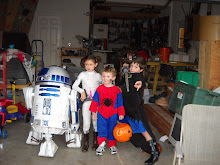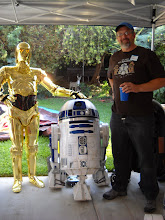
If I had any sense, I'd buy the booster covers in resin for $60 and save myself the work and expense. As it is, I spent a good bit more than that getting a couple of router bits and things to build them myself. But clearly, building your own R2 model isn't about having any sense. So I tackled building the booster covers myself. And I enjoyed it for the most part.
I broke the assembly up into pieces that I figured could be easily cut, finished, and machined. So I made up the legs and the main body piece. And I attached the legs at the end using a separate cross piece. This beats trying to build two legs attached by the small piece at the top all at once. I knew that getting inside to make that little router cut would be hard.
I cut blanks for all piece out of 1/2" fiberboard--again this stuff sucks because of the dust it creates and the cancer it causes. If I did this again I think I'd try to do it in plastic--maybe PVC, although that would be costly.
Once I had the blanks glued up (you can get the fiberboard/MDF in thicker sheets, but this is what I had, and the glue up isn't hard once you get the hang of it), it wasn't very hard to first, cut the bevel cut across the top of them--53 degrees I think, and then I set up the router table to trim that bit out of the inside tops of the legs.

Here's the bigger blank that I made for the thicker top assemblies. The thing looks really complicated on the plans, but it all starts with a simple rectangle. I made extras of both here because it's easy when you're tooled up to crank out another one, and I've learned that having a few extras gives you some breathing room and space for mistakes. I find that when I'm doing a new bit like this, my technique get a lot better after the first one.
Next up, I set up the router with an itty bitty round groove bit, set the fence at the right distance, and set up a stop block on the fence to make sure that I got all of them the same length. Then I ran the legs into the router and put this cute little channels into the bottoms. Pretty easy compared to some stuff so far. The channel groove that goes around the legs horizontally above the vertical round grooves isn't hard with the table saw. I checked my main leg assemblies to make sure that the groove on the legs lines up with the groove on them. Vic Franco said that some of the resin booster covers can heat up and warp out of alignment in the curing process and not line up here.

That smear on the left leg, as far as I can tell, is chocolate ice cream from my two year old who was investigating the work bench. I am hoping it will cover over with paint. When he sees the pieces laying around he shouts, "Doo-Deet, Doo-Deet!" It's pretty cute.

Next up I went to work on the top section of the booster covers. Here you can see the funky curve sanded into the top, the side bevels on the curve, and the pockets in the bottom of the block. Here's what I did. The bevel cuts on the top weren't hard. I measured them off according to the plans, and then I cut them with the bandsaw and sanded them (If memory serves.). Then I marked off the curves on the front and back. The curve is beveled--that is, it doesn't cut through at a 90 degree angle from the front face. I think that some people out there have done this part by using a sanding drum on their drill presses and tilting the table on the drill press. That's a simple and elegant solution. As it turns out, the drum on the end of my belt sander was almost exactly the right diameter for this. So I got the curves marked on the front and back and I very slowly sanded away the material until it matched those lines. Not hard.
I made pockets again by cutting all the way through the block with the router table. I think it's a .3" bit or thereabouts and set to .75" depth. Then I cut some replacement blocks to squeeze down into the channel and leave only the two pockets. Next I'll rout the cove out of this bottom face. The plans call for a 5/8" cove. Bits in that size are hard to find. You can order one, but they are $50 or so. I opted for a 1/2" cove bit which is much cheaper and easier to find. Then I think I'll use a 1 1/4" dowel and some sand paper to remove material to get it to spec. If that proves tedious--and I have a very low threshold for hand sanding tedium--I'll bail and leave it at 1/2" diameter, I think. If anyone has better ideas, I'm all ears.

And here's the whole thing so far laid out, along with the little triangular dog house pieces that sit on top. I made those in box form with 1/4" MDF and then cut and sanded them down to size. It'll take some trimming and detail work to get all of this assembled. But it's close to being done.







1 comment:
Excellent progress Matt! Very inspiring scratch-building, it is rare to see so many parts built by hand, especially the ones you have taken on of late.
-Victor
Post a Comment